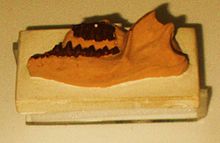Protungulatum
| Protungulatum Temporal range:lateMaastrichtiantoPuercan
| |
|---|---|

| |
| lower jaw ofProtungulatum donnae | |
| Scientific classification | |
| Domain: | Eukaryota |
| Kingdom: | Animalia |
| Phylum: | Chordata |
| Class: | Mammalia |
| Grandorder: | Ferungulata |
| Clade: | Pan-Euungulata |
| Family: | †Protungulatidae Chatterjee, Scotese & Bajpai, 2017[2] |
| Genus: | †Protungulatum Sloan &Van Valen,1965[1] |
| Type species | |
| †Protungulatum donnae Sloan & Van Valen, 1965
| |
| Species | |
Protungulatum('firstungulate') is anextinctgenusofeutherianmammalswithin extinct familyProtungulatidae,[2]and is possibly one of the earliest knownplacental mammals in the fossil record,that lived inNorth Americafrom theLate Cretaceousto earlyPaleocene.[6][3][7]
Fossils of this genus were first found in theBug Creek Anthillsin northeasternMontana.The Bug Creek Anthills were initially believed to be Late Cretaceous (latestMaastrichtian) because of the presence of the remains of non-aviandinosaursand common Cretaceous mammals,[8]but these were later shown to have beenreworked[a]from Late Cretaceousstrata,and consequently the Bug Creek Anthills are currently believed to be Early Paleocene (Puercan) in age.[9]Remains from theRavenscrag FormationofSaskatchewan,Canadahave been assigned toProtungulatum donnae.These remains may also be Cretaceous in age, but the age of theRavenscrag Formationis not entirely certain. In2011,remains of a new species in this genus,Protungulatum coombsifrom theHell Creek Formationsuggested thatProtungulatumwas present in both the Cretaceous and the Paleocene.[3]However, some later studies questioned this Late Cretaceous age for the genus, consideringProtungulatumto be exclusively Paleocene in age.[10]
Studies differ on the placement ofProtungulatum.This genus was initially assigned to the familyArctocyonidae,[11]in orderCondylarthra,[12][13](a group of archaic "ungulates", that is now known to bepolyphyletic). Some found that it is not a true placental mammal and it iseutherianfound to be close toPlacentalia.[14][3][15][16]However, a number of studies consider it to be a placental mammal and stem relative totrue ungulatesin cladePan-Euungulata,[17][18][19][20][7][21][22][10]based on anatomy ofinner ear.[7]

Phylogeny
[edit]The phylogenetic relationships of genusProtungulatumare shown in the following cladogram.[17][20]
| Scrotifera |
| |||||||||||||||||||||||||||||||||||||||||||||
Notes
[edit]- ^A derived or reworked fossil is a fossil found in rock made significantly later than when the fossilized animal or plant died: it happens when a hard fossil is freed from a soft rock formation by erosion and redeposited in a currently forming sedimentary deposit.
References
[edit]- ^R. E. Sloan and L. Van Valen (1965.) "Cretaceous mammals from Montana." Science 148(3667):220-227
- ^abSankar Chatterjee, Christopher R. Scotese, Sunil Bajpai (2017)"Indian Plate and Its Epic Voyage from Gondwana to Asia: Its Tectonic, Paleoclimatic and Paleobiogeographic Evolution",Geological Society of America, Volume 529
- ^abcdArchibald, J. David; Zhang, Yue; Harper, Tony; Cifelli, Richard L. (May 6, 2011)."Protungulatum,confirmed Cretaceous occurrence of an otherwise Paleocene eutherian (placental?) mammal "(PDF).Journal of Mammalian Evolution.18(3): 153–161.doi:10.1007/s10914-011-9162-1.S2CID16724836.Archived fromthe original(PDF)on March 3, 2016.RetrievedApril 28,2013.
- ^L. M. Van Valen (1978.) "The beginning of the Age of Mammals." Evolutionary Theory 4:45-80
- ^J. D. Archibald (1982.) "A study of Mammalia and geology across the Cretaceous-Tertiary boundary in Garfield County, Montana." University of California Publications in Geological Sciences 122:1-286
- ^Z. Kielan-Jaworowska, R. L. Cifelli and Z. X. Luo (2004.) "Mammals from the age of dinosaurs: Origins, evolution, and structure." Columbia University Press, New York 1-630
- ^abcMaeva Orliac (2016.)"The inner ear ofProtungulatum(Pan-Euungulata, Mammalia) "Journal of Mammalian Evolution 23(4)
- ^Z. Kielan-Jaworowska, T. M. Bown and J. A. Lillegraven (1979.) "Eutheria." In J. A. Lillegraven, Z. Kielan-Jaworowska, W. A. Clemens (eds.), "Mesozoic mammals: the first two-thirds of mammalian history" 221-258
- ^D. L. Lofgren (1995.) "The Bug Creek problem and the Cretaceous-Tertiary transition at McGuire Creek, Montana." University of California Publications in Geological Sciences 140:1-185
- ^abVelazco, Paúl M.; Buczek, Alexandra J.; Hoffman, Eva; Hoffman, Devin K.; O’Leary, Maureen A.; Novacek, Michael J. (June 2022)."Combined data analysis of fossil and living mammals: a Paleogene sister taxon of Placentalia and the antiquity of Marsupialia".Cladistics.38(3): 359–373.doi:10.1111/cla.12499.ISSN0748-3007.
- ^R. Tabuce, J. Clavel and M. T. Antunes (2011.) "A structural intermediate between triisodontids and mesonychians (Mammalia, Acreodi) from the earliest Eocene of Portugal." Naturwissenschaften 98:145-155
- ^Malcolm C. McKenna, Susan K. Bell:Classification of Mammals: Above the Species Levelin Columbia University Press, New York (1997), 631 Seiten.Protungulatum
- ^J. D. Archibald (1998.) "Archaic ungulates (" Condylarthra ")." In C. M. Janis, K. M. Scott, and L. L. Jacobs (eds.), "Evolution of Tertiary Mammals of North America" 1:292-331
- ^Wible, J. R.; Rougier, G. W.; Novacek, M. J.; Asher, R. J. (2007). "Cretaceous eutherians and Laurasian origin for placental mammals near the K/T boundary".Nature.447(7147): 1003–1006.Bibcode:2007Natur.447.1003W.doi:10.1038/nature05854.PMID17581585.S2CID4334424.
- ^Halliday, Thomas J. D. (2015)."Resolving the relationships of Paleocene placental mammals"(PDF).Biological Reviews.92(1): 521–550.doi:10.1111/brv.12242.PMC6849585.PMID28075073.
- ^Halliday, Thomas John Dixon; Upchurch, Paul; Goswami, Anjali (2016-06-29)."Eutherians experienced elevated evolutionary rates in the immediate aftermath of the Cretaceous–Palaeogene mass extinction".Proceedings of the Royal Society B: Biological Sciences.283(1833): 20153026.doi:10.1098/rspb.2015.3026.PMC4936024.PMID27358361.
- ^abO'Leary, Maureen A.; Bloch, Jonathan I.; Flynn, John J.; Gaudin, Timothy J.; Giallombardo, Andres; Giannini, Norberto P.; Goldberg, Suzann L.; Kraatz, Brian P.; Luo, Zhe-Xi; Meng, Jin; Novacek, Michael J.; Perini, Fernando A.; Randall, Zachary S.; Rougier, Guillermo; Sargis, Eric J.; Silcox, Mary T.; Simmons, Nancy B.; Spaulding, Micelle; Velazco, Paul M.; Weksler, Marcelo; Wible, John R.; Cirranello, Andrea L. (8 February 2013). "The Placental Mammal Ancestor and the Post–K-Pg Radiation of Placentals".Science.339(6120): 662–667.Bibcode:2013Sci...339..662O.doi:10.1126/science.1229237.hdl:11336/7302.PMID23393258.S2CID206544776.
- ^Wilford, John Noble (7 February 2013)."Rat-Size Ancestor Said to Link Man and Beast".New York Times.Retrieved9 February2013.
- ^Averianov, A. O. & Lopatin, A. V. (2014.)"High-level systematics of placental mammals: Current status of the problem."Biology Bulletin, 41(9), 801–816.
- ^abBurger, Benjamin J. (2015).The Systematic Position of the Saber-Toothed and Horned Giants of the Eocene: The Uintatheres (Order Dinocerata)(PDF).Society of Vertebrate Paleontology 75th Annual Meeting. Dallas.Conference abstract (p. 99)Archived2019-12-24 at theWayback Machine.Explanation and conclusions:Episode 17: Systematic position of the Uintatheres (Order Dinocerata)onYouTube.
- ^Upham, N. S.; Esselstyn, J. A.; Jetz, W. (2021)."Molecules and fossils tell distinct yet complementary stories of mammal diversification".Current Biology.31(19): 4195–4206.e3.doi:10.1016/j.cub.2021.07.012.PMC9090300.PMID34329589.
- ^Carlisle, E.; Janis, C. M.; Pisani, D.; Donoghue, P. C. J.; Silvestro, D. (2023)."A timescale for placental mammal diversification based on Bayesian modeling of the fossil record".Current Biology.33(15): 3073–3082.e3.doi:10.1016/j.cub.2023.06.016.
